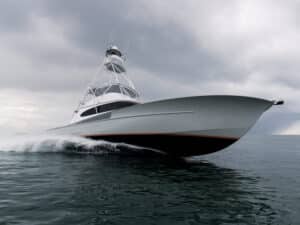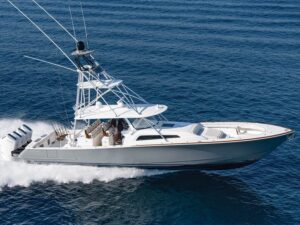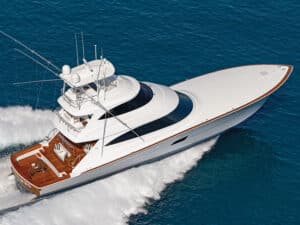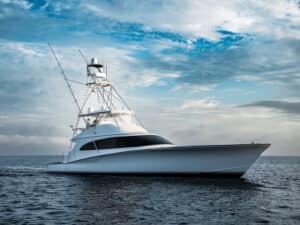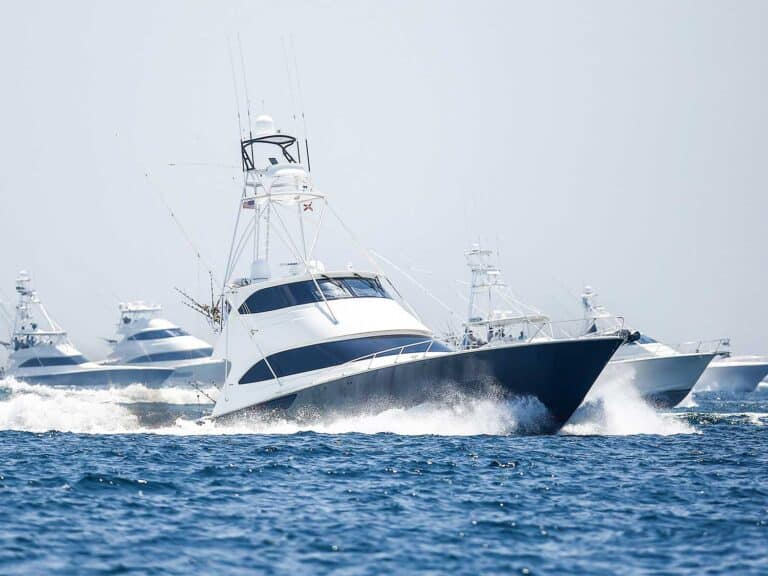Bertram has produced plenty of great hulls in its time. In the minds of many, classic hulls like the Bertram 54 and 31 have never been surpassed as offshore fishing boats. Whether you’re grown up a fan of Bertram’s or not, you might want to take a look at the company’s newest entry into the 50-foot class. It may not have the most traditional lines or interior, but it runs with the best of them in ugly conditions – and that’s just what we had when I had the opportunity to fish the 510. Winds out of the southeast at 20 knots made offshore conditions a tad unpleasant. But for testing a boat, who could ask for anything better? After all, almost every boat performs well in flat calm.
In fact, if it weren’t for the close-together rough seas, I couldn’t honestly say that this may be the best-performing fishing boat Bertram has built since the original 54. The props and gearing combination did take a healthy 15 seconds to get the 510 up on plane and 22 seconds to reach 30 knots. However, you’ll get a very respectable 36-plus-knot top speed out of her. At 35.5 knots, you get a range of about 320 nautical miles, but dropping that back to 28 knots affords a range of 480 miles.
Running downwind in a quartering sea, the 510 provides hands-off control. Yes, it heels over slightly when it meets the back of the next wave, but it doesn’t alter course in the slightest. I found that the trim tabs were slow to respond and provided limited bow travel. However, with that said, they certainly did exactly what they needed to for head sea/down-sea and trim adjustment. And no matter what point of sea you’re heading into, the 510 leans into and carves a turn with grace.
In south Florida, we do a lot of drift fishing for sails, so a boat has to handle sitting still in big seas. Once I pointed its bow into the wind, the 510 took a long time to fall off the wind and come beam-to the seas, meaning it doesn’t blow around easily. Anglers didn’t even have to hold on in the 4- to 6-foot seas nearshore. The roll moment proved slow and the transitions gentle.
The cockpit has loads of room for multiple anglers to fight fish simultaneously, and West Coast anglers will particularly appreciate the ability to plumb the nonskid-covered bow for a live baitwell. Handholds going forward seemed adequate and secure, as they did up on the flying bridge and in the salon, two places they’re often overlooked. In general, the cockpit contains most amenities any serious angler would demand: a large circular baitwell to starboard, tackle station on centerline with a sink and drawers beneath, a large freezer outboard to port and the engine room hatch next to the salon door. Shore power and washdown spigots can be found in each under-gunwale coaming. Bertram included a feature I always suggest to builders – a single tube molded into each side under the gunwale for gaff and mop storage. About the only real improvement I would suggest is to use the space under the salon steps for an insulated cockpit drink box.
Inside, choice of furniture and placement belongs to the buyer. Our test boat sported an L-shaped settee to port, but with the bottom of the L along the forward end rather than across the aft bulkhead. hate to try to sleep there on the way to the canyons in any kind of sea. The interior features gorgeous cherry wood with a flawless gloss finish, while the galley boasts all the latest amenities.
Three steps down finds a double cabin amidships with twin beds. Portside, the master stateroom holds an island double berth and private head with shower. Another double in the bow offers an island berth on centerline and shares a starboard-side head and shower with the other guest cabin.
The engine room hatch from the cockpit provides plenty of wiggle room to enter and exit, and anyone under 5 feet 7 inches tall will have full standing headroom. The compartment has been laid out with an eye toward ease of maintenance, with filters and fuel valves on the forward bulkhead and generators, batteries and air conditioning compressors all in their own space aft under the cockpit deck.
